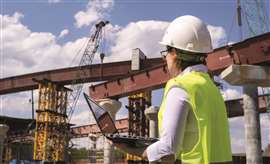Why is construction still suffering a labour squeeze and what are the solutions?
24 August 2023
 Image: Adobe Stock
Image: Adobe Stock
Recession may be looming in some construction markets around the world but a shortage of skilled construction workers remains a major challenge to the industry.
That’s particularly the case in advanced economies. In the US, for example analysis from Associated General Contractors of America (AGC) shows that the industry added 19,000 jobs in July even as the unemployment rate rises. Average sector pay increased to $34.24 an hour amid strong demand.
Earlier this year, Associated Builders and Contractors (ABC), a US-based national construction trade association, put the shortage of construction workers at 546,000 in 2023 – that’s half a million workers over and above the normal pace of hiring, in order to meet demand. Separately, the ABC’s latest Construction Confidence Index indicates that a majority of contractors expect to increase their staffing level over the next six months.
It’s a similar story in other countries. In the UK, for example, the Construction Skills Network estimates that the construction industry there will need an extra 225,000 workers by 2027, even taking into account a recession in 2023.
And construction roles made up five of the top 10 shortage occupations in Europe for 2023, according to a report by the European Labour Authority, published in March. They were: bricklayers; carpenters and joiners; plumbers and pipe fitters; building and related electricians; and concrete placers, concrete finishers and related workers.
The causes
In advanced economies, one of the main causes of a shortage of workers is demographics. In the US, nearly a quarter of construction workers are older than 55 and significant numbers are either at or close to retirement age.
“When asked about what main factor is impacting the severity of the skilled labour shortage, one issue stood out: The retirement of baby boomers,” says Tim Mongeau, director of workforce development at Associated Builders and Contractors (ABC). “It’s estimated that by 2030, 40% of the construction workforce will retire. This cuts across all industry occupations. Unfortunately, this translates into many more people leaving the industry than new entrants coming in.”
 Image: Allistair/peopleimages.com via AdobeStock - stock.adobe.com
Image: Allistair/peopleimages.com via AdobeStock - stock.adobe.com
The Chartered Institute of Building in the UK has separately calculated that the number of construction employees above 60 is accelerating faster than any other age group.
Compounding that problem is the fact that those younger workers who are entering the industry tend to be unskilled, at least to start with.
ABC found that in the US, four out of every 10 new workers since 2012 were unskilled labourers and likely to be less productive than their older and more skilled counterparts.
ABC’s chief economist Anirban Basu said, “While single-family home building activity has moderated, many contractors continue to experience substantial demand from a growing number of mega-projects associated with chip manufacturing plants, clean energy facilities and infrastructure.
“Too few younger workers are entering the skilled trades, meaning this is not only a construction labour shortage but also a skills shortage.”
Strong investment in certain markets and the push towards net zero is also likely to exacerbate that challenge, generating more construction openings.
UN Secretary-General António Guterres has claimed that 30 million jobs in renewable energy and energy efficiency must be created worldwide by 2025.
Meanwhile, the problem cascades down to emerging economies, where skilled workers in those countries are tempted away by the promise of better pay elsewhere.
There are anecdotal reports of construction managers in India struggling to find enough skilled workers because of the strong draw that major projects underway in the Middle East creates, for example.
The knock-on effect of these shortages is that the risk that both delays and costs increase, with contractors having to pay higher wages to attract the workers they need.
Solutions
So are there ways in which construction companies and policymakers can mitigate the effects of the labour and skills crisis?
And how can the industry put itself on a better footing for the future?
Here are eight potential solutions:
- Create a positive work environment: While there have been improvements in recent years, construction still suffers from a perception – truer in some markets than others – that it is a dirty and dangerous job. But efforts to provide safer working conditions and opportunities for advancement and communicating those changes to would-be entrants to the industry can help.
- Encourage more young people to enter construction. Successful initiatives include Germany’s ‘Azubi am Bau’ programme, which uses advertising and social media to showcase construction careers to the young and unemployed. In Australia, the Construction Industry Training Board has funded new apprenticeship incentives including free driving lessons, AU$500 towards equipment, and cash bonuses for completing the first year. In the UK, the Open Doors programme offers young people behind-the-scenes visits to projects like Europe’s largest infrastructure project, HS2.
- Increase gender diversity. Construction is a male-dominated industry but research by the US General Services Administration showed that construction companies that are highly engaged in diversity and inclusion found that they became more competitive. French company Vinci is among many contractors in the market now trying to enhance diversity in their workforces. Vinci’s female directors and managers established the ‘mYXt network’, which monitors the promotion of access to management positions for women, and encourages sharing gender equality best practice.
-
Investment in training and apprenticeships: Apprenticeship starts declined in multiple markets in 2020 as a result of the Covid-19 pandemic, making investment in programmes all the more important now as they increase again. ABC highlighted the importance of offering a programme of education and upskilling to new construction recruits and advocated partnering with local carer and technical education centres that have preapprenticeship programmes and offer opportunities for job shadowing and project tours. It claimed that its members have so far invested $1.2 billion in 2021 to educate 1.3 million course attendees via a national network of more than 800 apprenticeship, craft, safety and management education programmes. But there is a question mark over whether or not there are enough places available to meet industry demand. In the UK, the Construction Industry Training Board (CITB) warned in December 2022 that the number of annual apprenticeship starts needs to be two to three times higher than current levels due to poor completion rates and the loss of older workers.
- Partnerships with educational institutions: Although relationships can be difficult to set up and maintain, construction companies can benefit from creating closer ties with educational institutions. UK contractor Morgan Sindall recently became the first construction company to form a partnership with Developing Experts, an education platform that changes how children learn how science, technology, engineering and maths (STEM) applies to the world of work. Morgan Sindall helped to devise a bespoke set of lessons that reflects the range of careers available in construction and helps children, teachers and parents understand how construction relates to their lives.
- Boosting productivity with new technology: Canadian business SNC-Lavalin reports that its subsidiary Atkins is doing more with fewer people by implementing artificial intelligence and the Internet of Things (IoT). US homebuilder Lennar is working with technology company ICON to 3D print 100 homes near Austin, Texas. Robots and drones are starting to take on basic or dangerous surveying work – in the UK, Mace is using a Boston Dynamics ‘Spot’ robot dog mounted with a Trimble X7 scanner to survey a 1960s survey tunnel under Heathrow Airport.
- Harnessing transferrable skills: Economically displaced workers from other sectors with relevant skills provide an opportunity for construction businesses. A UK study suggested that as the move towards net zero continues, skilled workers from the oil and gas and aviation industries could find a place in construction roles.
- Advocating for policy change: This includes policies that make it easier to hire foreign workers, provide tax breaks for construction companies, and invest in infrastructure. The National Association of Home Builders in the US has called for immigration reform to address employers’ seasonal needs. And in 2022, Malaysia signed an agreement with Indonesia to match Indonesian workers with suitable employers, combined with strengthened wage protection and complaint mechanisms.
STAY CONNECTED



Receive the information you need when you need it through our world-leading magazines, newsletters and daily briefings.
CONNECT WITH THE TEAM









